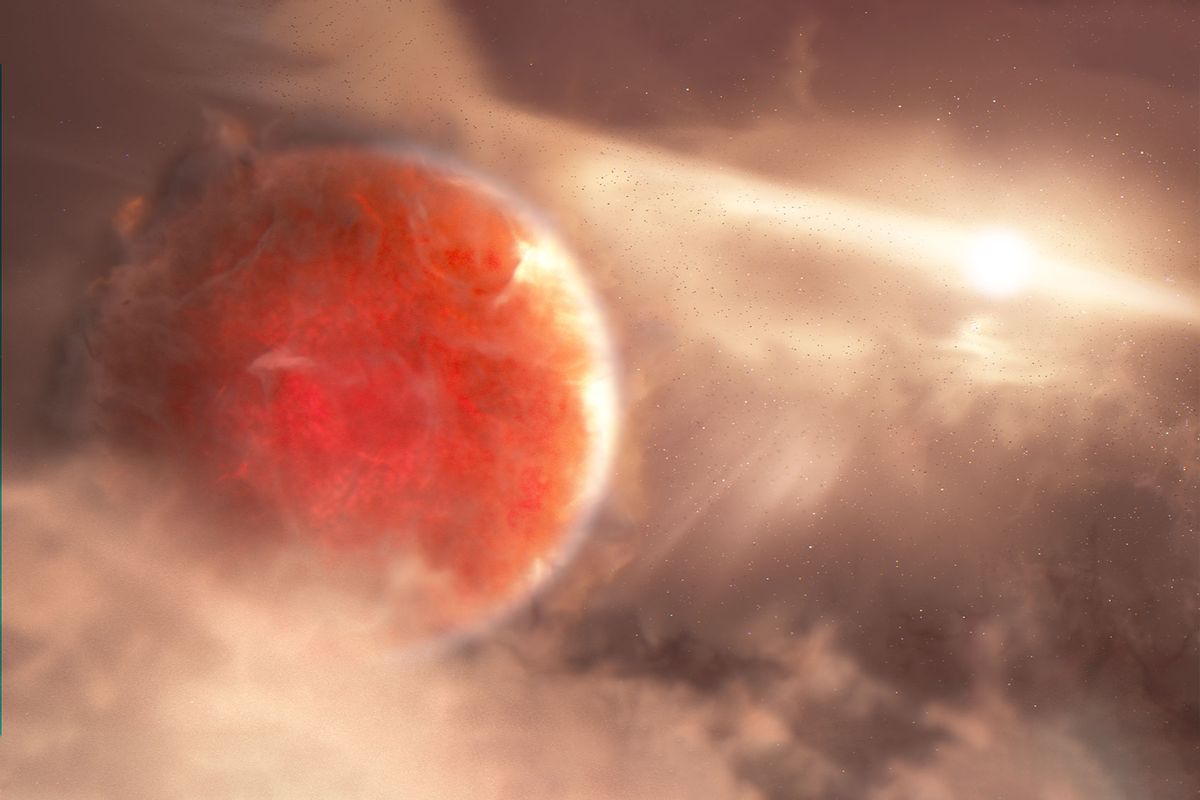Hubble discovers a Jupiter-like planet forming in a very strange way

Jupiter, the largest planet in the solar system, might seem utterly alien from the perspective of an Earthling. It has no immediate solid surface, but rather is a gas giant, largely comprised of hydrogen and helium. Its atmosphere is so dense that huge storms many times the size of Earth, such as the one contained in its Giant Red Spot, persist for centuries.
But despite its bizarre composition compared to Earth, Jupiter-like planets are actually exceedingly common in the galaxy. Indeed, astronomers observe gas giants of similar makeup everywhere they look. It is believed that the reason that Jupiter-like worlds are so common is because most solar systems like ours form in a similar way. Our solar system started life as a rotating, disk-shaped cloud of gas and dust; at its central point, some gas slowly accreted into a star (our sun); other bits of gas and dust accreted into small rocks that became large rocks, which eventually accrued into planets.
From there, our solar system — and similar ones, as we have observed — underwent a similar evolution: the radiative pressure from the sun pushed lightweight gases like hydrogen and helium outwards to the outer solar system, at which point they accrued around the more distant objects. This is what gives the solar system the interesting pattern it has, of rocky inner planets with slight atmospheres of heavier gases like nitrogen and carbon dioxide and oxygen, and outer planets with (we suspect) rocky cores and huge shells of hydrogen and helium gas.
That is all relatively well-understood. But the initial stage of planet formation — the move from a diffuse cloud of gas and dust to a solar system with a central star and rocky and/or gaseous worlds spread out in a chain — is a bit hazier.
Hence, for gas planets like Jupiter, the dominant theory as to how they first originate is known as “core accretion,” a process that is similar to how terrestrial planets like Earth form. In this theory, a planet undergoes a two-stage process where the core is formed via multiple collisions between planetesimals, which are essentially pieces of cosmic dust.
RELATED: Finding ET through pollutants
However, one long-debated theory about how planets like Jupiter form is known as “disk instability.” In this theory, scientists hypothesize that a planet like Jupiter forms when part of a circumstellar disk becomes dense and cool enough to be vulnerable to gravitational collapse. According to the theory, this can result in the formation of a gaseous “protoplanet,” which is essentially a planet embryo. But until now, scientists haven’t been able to directly observe such a process.
On Monday, a study published in the April 4 issue of Nature Astronomy shows that the Hubble Space Telescope has directly photographed evidence of a protoplanet — called AB Aurigae — going through an “intense and violent process.” Scientists believe this is evidence that directly supports the “disk instability” theory of planet formation.
Want more health and science stories in your inbox? Subscribe to Salon’s weekly newsletter The Vulgar Scientist.
“This new discovery is strong evidence that some gas giant planets can form by the disk instability mechanism,” Alan Boss of the Carnegie Institution of Science in Washington, D.C., said in a press statement. “In the end, gravity is all that counts, as the leftovers of the star-formation process will end up being pulled together by gravity to form planets, one way or the other.”
Scientists estimate that the newly forming planet is nine times more massive than Jupiter. It orbits its host star at a distance of 8.6 billion miles. To put that into perspective: scientists estimate that this planet is over two times the distance from its host star than Pluto is from our Sun. Due to its distance from its host star, researchers have concluded that the only way a planet can form from such a great distance is via disk instability.
The new analysis stems from data collected by two separate Hubble Telescope instruments: the Space Telescope Imaging Spectrograph and the Near Infrared Camera and Multi-Object Spectrograph.
“Interpreting this system is extremely challenging,” said Thayne Currie, lead researcher on the study, in a press statement. “This is one of the reasons why we needed Hubble for this project – a clean image to better separate the light from the disk and any planet.”
Currie said the discovery is in part due to the Hubble Space Telescope’s instruments, but also in part thanks to the telescope’s longevity. Hubble launched into Earth’s low orbit in 1990 and has remained in operation ever since.
The immense distance from its host star meant that the object was so dim and slow-moving that at first scientists weren’t convinced that B Aurigae b was a planet.
“We could not detect this motion on the order of a year or two years,” Currie said. “Hubble provided a time baseline, combined with Subaru data, of 13 years, which was sufficient to be able to detect orbital motion.”
Scientists say that understanding how planets like Jupiter form will provide them with a better understanding of how our own solar system was created.
“Nature is clever; it can produce planets in a range of different ways,” Currie said.
More stories on astronomy:


